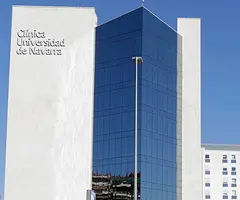Acute Leukemia
"Currently, the survival of patients with this disease has been considerably increased".
DR. MARÍA MARCOS
SPECIALIST. HEMATOLOGY AND HEMOTHERAPY DEPARTMENT

Acute leukemias are neoplastic proliferations of immature hematopoietic cells whose progressive accumulation is accompanied by a decrease in the production of normal blood cells (decrease in leukocytes, red blood cells and platelets).
Within acute leukemias there are two large groups, depending on the type of cell that proliferates (lymphoblastic leukemia if the neoplastic cell is of lymphoid origin, or myeloblastic leukemia if the neoplastic cell is of myeloid origin).
Acute lymphoblastic leukemia is more frequent in children than in adults. However, acute myeloblastic leukemias are more frequent as age increases.

A PERSONALIZED MEDICINE
Second Opinion,
peace of mind
Request a second opinion from our professionals with great experience in the diagnosis and treatment of oncological diseases
In 3 days, without leaving home.
Symptoms of acute leukaemia
Tiredness and weakness
This symptom is directly related to the disease itself and the decrease in red blood cells due to bone marrow invasion.
Weight loss
This is usually a general symptom of acute leukaemia and may be accompanied by other signs such as weakness and fatigue.
Heavy night sweats
This can be intense and affect the quality of sleep.
Anaemia
Invasion of the bone marrow by leukaemic cells reduces red blood cell production, resulting in anaemia.
Enlarged lymph nodes
The infiltration of leukaemic cells into the lymphatic system can lead to enlarged lymph nodes in different areas of the body.Increased susceptibility to infections
The displacement of normal white blood cells by leukaemic cells alters the capacity of the immune system, increasing the risk of frequent or severe infections.
Tendency to haemorrhage
Decreased platelet count due to leukaemic infiltration of the bone marrow can lead to spontaneous bleeding or haemorrhage of varying intensity.
Spontaneous bone pain or pain on pressure
In some cases, especially in children, bone pain may be a prominent symptom. This pain can be confused with rheumatic diseases.
Hypertrophy of the gums
Invasion of leukaemic cells into the oral cavity can cause thickening or swelling of the gums, affecting their appearance and function.
Do you have any of these symptoms?
If you suspect that you have any of the above symptoms,
you should consult a medical specialist for a diagnosis.
What are the causes of acute leukaemia?
The origin of the disease is unknown, but there are some factors associated with its development: radiation, chemicals, drugs, genetic factors, viruses, etc.
Prognosis of acute leukaemia
Until not so long ago, the mortality rate of acute leukaemia was very high in a short time. However, we can now speak of a cure for some specific types of acute leukaemia. In many other cases, survival has been significantly increased.
How is acute leukaemia diagnosed?
The diagnosis of acute leukaemia is often suspected on the basis of clinical symptoms (haemorrhages, intense pallor, infections, high fever, etc.).
Confirmation of the diagnosis is made by blood tests and bone marrow puncture.
Nowadays, flow cytometry, cytogenetics and molecular biology analyses are indispensable for the exact diagnosis of the individual subtypes of acute leukaemia.
The treatment of acute leukaemias today is still chemotherapy. Schemes vary depending on the type of acute leukaemia.
How is acute leukaemia treated?
The treatment of acute leukaemias today is still chemotherapy. Schemes vary depending on the type of acute leukaemia.
Bone marrow transplantation plays a very important role in the treatment, either autologous (from the patient) or allogeneic (from a donor) depending on multiple factors, and each case must be individualised.
Nowadays, new drugs and new therapeutic strategies are being developed, not only to destroy the neoplastic cell, but also to inhibit its growth and favour its differentiation.
These include retinoic acid derivatives, new monoclonal antibodies combined with chemotherapy and gene therapy.
What clinical trials do we have on Acute Leukemia?
Advanced Therapies Unit
The Advanced Therapies Unit of the Clínica Universidad de Navarra develops cell therapies against cancer and other diseases of the immune system.
It is implemented by a highly specialised multidisciplinary team of nurses, together with doctors from all the specialties involved.
Where do we treat it?
IN NAVARRA AND MADRID
The Hematology and Hemotherapy Service of the
at the Clínica Universidad de Navarra
The Hematology Service of the Clinic, formed by specialists of recognized national and international prestige, has integrated molecular diagnostic techniques and the use of new personalized treatments in its assistance work, allowing a more precise and fast diagnosis of the hematological diseases.
The joint work of the medical staff and the researcher facilitates the development and application of the new treatments and at the same time the precise evaluation of the result of the treatments.

Why at the Clinica?
- Experts in the development of Cellular Therapy treatments.
- International reference center in lymphomas, multiple myeloma and monoclonal gammopathies.
- Experts in the diagnosis and treatment of hemorrhagic and thrombotic problems.
Our team of experts in acute leukaemia





























